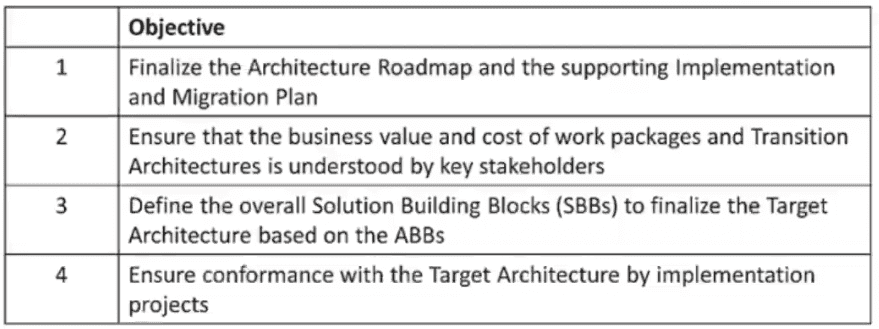Please read this scenario prior to answering the question
You are working as an Enterprise Architect within a healthcare and life science company. The company is a
leading player in its industry, dedicated to transforming healthcare with new ideas and advancements. The
company has multiple divisions that cover different aspects of the business.
The company's Enterprise Architecture (EA) department has been operating for several years and has
mature, well-developed architecture governance and development processes following the TOGAF
Standard. In addition to the EA program, the company has a number of management frameworks in use.
The Architecture Board includes representatives from each division of the company.
Many of the company's rivals have begun utilizing Artificial Intelligence (Al) in their operations, and the
indications are that this will be transformative for healthcare delivery. This is something the EA department
has been interested in for a while, and they had recently submitted an architecture Change Request which
was approved. As a result, the CIO has approved a Request for Architecture Work to investigate the
implementation of Al in the company.
Areas for evaluation include:
How can staff use Al daily in their current role?
How Al can enhance access to care for patients, and how to make that experience seamless?
How Al can offer new workplace platforms and tools to increase efficiency?
Some of the top managers are worried about a change in the way of working, and if it will achieve the goals.
Many are not confident that the company's risk management processes are adequate for a company-wide
integration of generative Al. There are also questions from staff about whether enough specific guidelines
and polices have been put in place for responsible use of Al.
The Chief Information Officer (CIO) is the sponsor of the Enterprise Architecture program. The CIO has
actively encouraged architecting with agility within the EA department as her preferred approach for projects.
The CIO wants to know how to address these concerns and reduce risks.
Refer to the scenario
You have been tasked with starting the architecture development. How do you begin?
Based on the TOGAF standard which of the following is the best answer?
Show Answer
Hide Answer
Correct Answer:
A
Key aspects of the scenario:
Objective:
Integrating Artificial Intelligence (AI) into healthcare delivery, with a focus on improving patient care, enhancing workplace efficiency, and enabling seamless experiences.
Challenges:
Stakeholder concerns about risk management, adaptability to change, and ensuring alignment with regulations and policies.
Addressing the concerns of staff and top management about AI integration and achieving the desired goals.
CIO's Perspective:
Encouraging an agile approach to architecture development.
Addressing risks and ensuring stakeholder concerns are managed.
Areas for Evaluation:
AI usage by staff and impact on workflows.
Patient experience enhancement via AI.
New workplace platforms and tools powered by AI.
Option Analysis:
Option 1: Analysis of stakeholders and development of a Stakeholder Map
Pros:
Stakeholder analysis is critical for identifying concerns, viewpoints, and requirements.
TOGAF emphasizes stakeholder engagement early in the process to mitigate risks and align expectations.
Developing a Stakeholder Map ensures clear alignment with their interests and creates a foundation for regular feedback loops.
Cons:
Does not explicitly address the creation of architecture models or policies upfront.
Option 2: Creation of a Communications Plan
Pros:
A communications plan fosters effective stakeholder engagement by addressing their concerns and ensuring transparent reporting.
Risk mitigation as part of communication aligns with TOGAF's stakeholder management practices.
Cons:
This focuses more on communication mechanics rather than advancing architectural development directly.
Option 3: Models for Draft Business, Data, Application, and Technology Architectures
Pros:
Aligns with the Architecture Development Method (ADM), ensuring compliance with requirements and regulations.
Helps formalize stakeholder feedback by verifying their concerns against tangible models.
Cons:
Developing detailed models early on may delay immediate resolution of stakeholder concerns and risk mitigation.
Option 4: Set of reusable business models for AI-related projects
Pros:
Standardized models ensure consistency and portability across the organization's AI-related efforts.
Cons:
Too narrow in focus for the initial architecture development phase; does not address risk management or stakeholder concerns adequately.
Recommended Answer:
Option 1: You recommend that an analysis of the stakeholders is undertaken.
Reasoning:
The scenario highlights stakeholder concerns about risks, adaptability, and compliance. Addressing these concerns requires stakeholder analysis as the first step.
A Stakeholder Map aligns with TOGAF's emphasis on stakeholder engagement, providing a structured way to manage their concerns and expectations.
Identifying concerns early and integrating feedback into the Architecture Vision document ensures alignment with goals and smooth progress.
Option 1 sets the foundation for collaboration and risk management, making it the best fit for the current phase.


